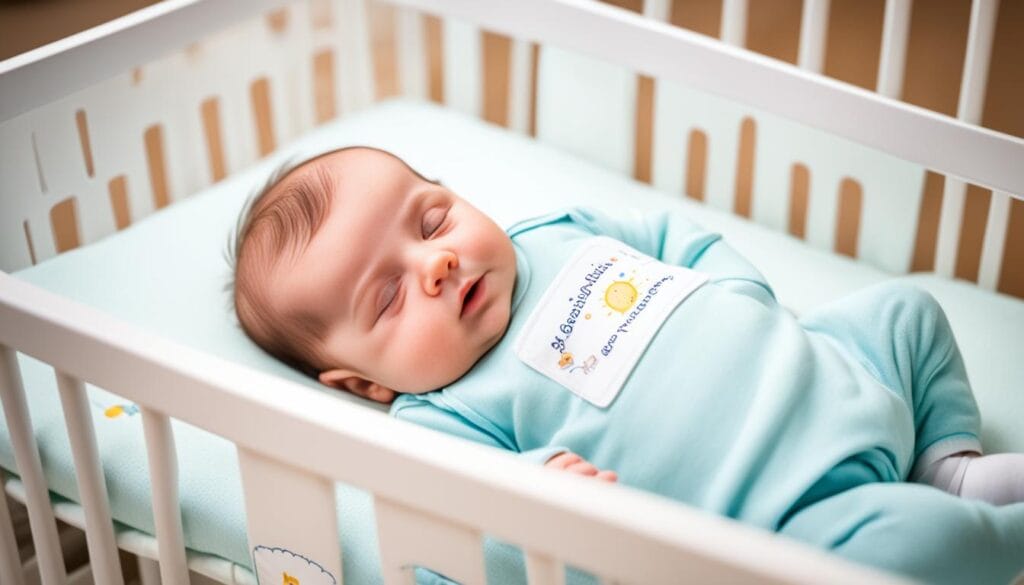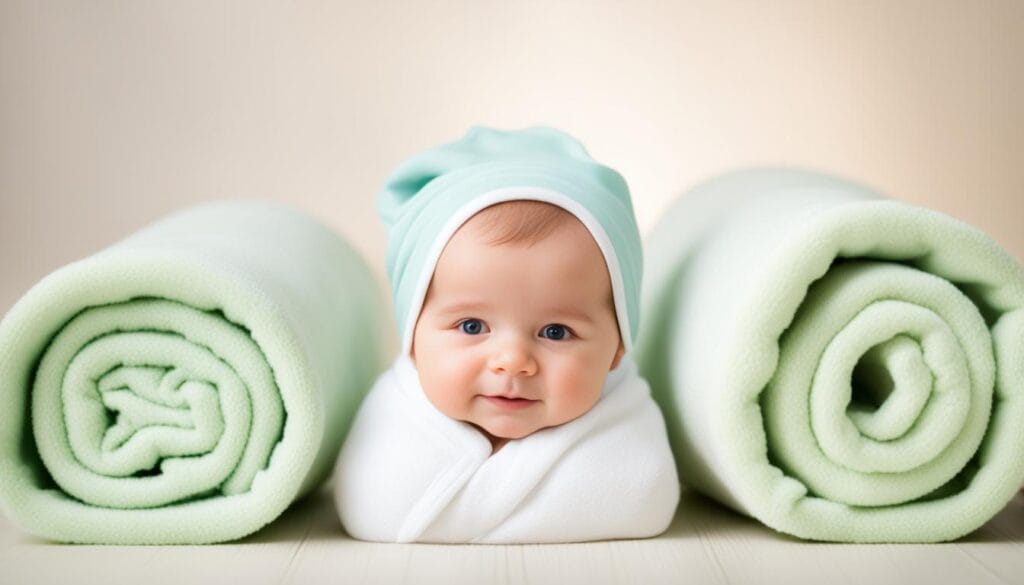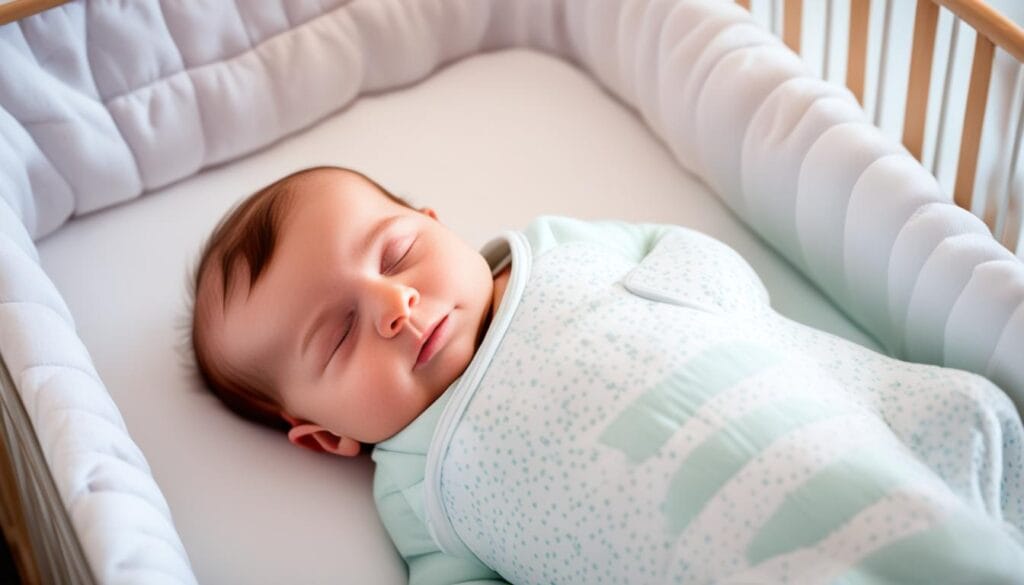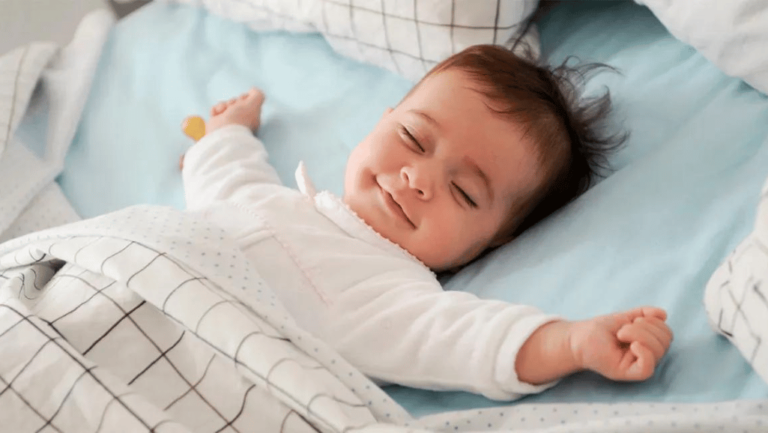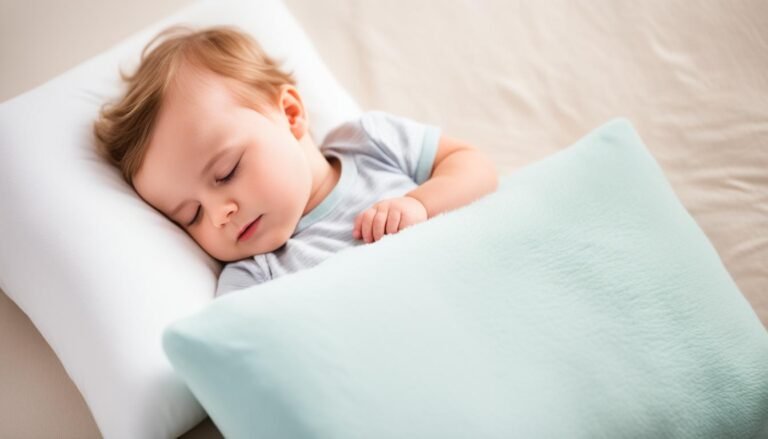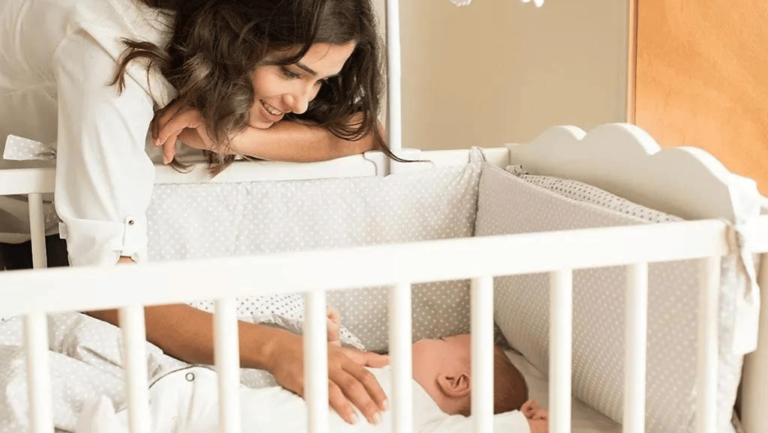It’s important to know when can baby sleep with pillow for safety. The American Academy of Pediatrics says newborns are safest without pillows. This rule is there to prevent risks of suffocation and Sudden Infant Death Syndrome (SIDS).
Wait until your child is moving to a toddler bed to use a pillow. This move happens between 18 months and 3 1/2 years. Parents should watch their toddlers to see when they are ready. Also, it’s best to pick a small and firm pillow for safety.
Key Takeaways
- Babies should sleep on a firm, flat surface until they are at least 12 months old.
- Delaying the introduction of pillows until transitioning to a toddler bed reduces suffocation risks.
- Soft bedding, including pillows and stuffed animals, increases the risk of SIDS.
- The American Academy of Pediatrics recommends waiting until age 2 for pillow use.
- Parents should choose firm, toddler-sized pillows when their child is ready for one.
Understanding Safe Sleep Practices for Babies
Keeping a sleeping baby safe is top priority for parents. The best safe sleep for babies means they sleep on a firm, flat surface. It’s also vital to keep loose bedding away. Now, let’s look at why these steps matter so much.
Importance of a Firm, Flat Sleeping Surface
A flat sleeping surface is key for a baby’s safety. It helps keep their airway clear, which lowers the risk of SIDS and suffocation. About 3,500 babies in the US die suddenly every year while sleeping. Placing babies on their backs to sleep on a firm, flat surface can reduce these risks greatly.
Avoiding Loose Bedding
It’s crucial to keep all loose bedding out of the crib. Things like pillows and soft toys can block a baby’s airway. By clearing the crib, parents make sleep safer. Plus, the chance of SIDS goes down by half if the baby sleeps in their own space but in the same room with parents.
Breastfeeding is another way to lower the SIDS risk. Experts suggest nursing exclusively for six months to help protect against it. Yet, using alcohol or drugs while pregnant increases the risk of infant sleep death.
Following these baby sleep safety tips creates a safer space for your little one. This brings parents comfort. For more info, check out the AAP’s safe sleep guide.
Risks of Using a Pillow for Baby
Introducing a pillow to your baby’s sleep area can be risky. It increases the chances of Sudden Infant Death Syndrome (SIDS) and suffocation. Factors like a baby’s small size and limited strength are reasons for these risks.
Increased Risk of SIDS
Studies show that using pillows with babies aged four to twelve months raises the SIDS risk. This period is already dangerous for SIDS. The American Academy of Pediatrics (AAP) advises against putting pillows in cribs to prevent SIDS.
Pillows can cause babies to get too warm and block their breathing. Because a baby’s head is shaped differently, a pillow could block their airway easily.
Potential for Suffocation
Aside from SIDS, pillows can cause suffocation dangers. Babies can’t move away if their face gets pressed into a pillow. This can result in suffocation accidents.
Pillows might tempt older babies to climb out of their crib. This could lead to falls and harm. Also, soft bedding can cause getting tangled or stuck, as babies can’t free themselves.
The AAP suggests waiting until a child is two before using a pillow. This can help keep your baby safe while sleeping. It reduces the risks of suffocation and other harms.
When Can Baby Sleep with Pillow
Finding the right time for your baby to use a pillow is super important. Experts like the American Academy of Pediatrics give us rules to keep our kids safe. They help us know when it’s okay to introduce pillows to our little ones.
American Academy of Pediatrics’ Recommendations
The American Academy of Pediatrics says no to pillows, blankets, and soft bedding for babies under 1 year old. This rule cuts the risk of suffocation and SIDS. After the first year, while you might think about adding pillows, there’s not enough proof that it’s totally safe. It’s wise to wait until your child is older to use a pillow.
Transitioning to a Toddler Bed
Patiently wait until your child moves to a toddler bed, which happens around 18 months to 3 1/2 years. This advice matches that of the American Academy of Pediatrics. They suggest holding off on pillows until your child is at least 2 years old. Choose a firm, toddler-sized pillow for both safety and comfort by then.
| Age | Sleeping Recommendations |
|---|---|
| 0-12 months | Firm, flat surface; no pillows or soft bedding |
| 12-24 months | Continue using no pillows; consider waiting until transitioning to a toddler bed |
| 18 months-3 1/2 years | Transition to toddler bed; introduce a firm, toddler-sized pillow |
Parents can make their child’s sleep area safer by sticking to these advice. It’s all about reducing pillow risks and making sure kids sleep well and safe.
Importance of a Flat Sleeping Surface for Baby
A flat sleeping surface is key for infants. It helps them breathe well while asleep. Also, it lowers the risk of SIDS (Sudden Infant Death Syndrome). Studies show that soft surfaces or sleeping with adult pillows can increase this risk. So, keeping the sleeping surface flat is vital according to the best sleep environment for newborns.
Soft surfaces, like couches and waterbeds, are dangerous for babies. They might accidentally cover their faces while sleeping. This leads to a risk of suffocation. Babies must sleep on a hard, flat surface, without pillows or soft bedding. The importance of a flat sleeping surface goes beyond preventing suffocation. It ensures that the baby’s airway is always clear.
Sharing a room with the baby, instead of the bed, also drops SIDS risk by 50%. This keeps the baby safe from soft and risky bedding. It’s crucial that babies sleep in environments without quilts, blankets, or soft materials. These can lead to suffocation or accidents.
To conclude, a firm, flat sleeping space is essential for the best sleep environment for newborns. Making sure their sleeping area is safe is very important. It keeps them healthy and away from harm.
Preventing Flat Head Syndrome Without a Pillow
It’s important to look at ways to prevent flat head syndrome in infants without using pillows. The FDA warns that infant head shaping pillows don’t work and may not be safe. Let’s find out about safe and effective alternatives.
Alternatives to Pillows
There are many safe options that can prevent flat head syndrome. For example, caps, helmets, or headbands that are FDA-approved. These help improve cranial symmetry and are good for moderate to severe types of flat head syndrome.
Tummy Time
Tummy time is super important. It builds neck and shoulder muscles, aiding a baby’s overall growth. It also reduces pressure on the back of the baby’s head, encouraging a well-shaped skull.
Changing Head Position During Sleep
To stop flat head syndrome, change your baby’s sleeping head position often. You can do this by turning their direction in the crib. This helps to spread pressure evenly over their skull.
| Practice | Benefit |
|---|---|
| Caps, Helmets, or Headbands | Improves cranial symmetry |
| Tummy Time | Strengthens neck and shoulder muscles |
| Changing Head Position | Even pressure distribution on skull |
By following these steps, you can reduce the risk of flat head syndrome and keep your baby safe. Avoiding pillows is key to a safer sleeping environment for your little one.
Infant Sleep Safety Recommendations
Making sure newborns sleep safely is very important. This lowers the risks of SIDS and suffocation. By following the American Academy of Pediatrics’ advice, parents can make a safe sleeping place for their little ones.
Bedside Sleepers as Alternatives
Bedside sleepers are a great choice for keeping newborns safe. They let the baby stay near their parents but in their own space. This makes it easy to check on the baby at night and for feeding, all without sharing a bed. It creates a safe space for the baby while feeling close to parents.
Using Firm Mattresses
Using a firm mattress is key for infant safety when sleeping. A firm mattress keeps a flat and stable surface, reducing the risk of suffocation. The mattress must fit tightly in the crib or bassinet. It should only have a fitted sheet, no pillows, loose bedding, or soft toys. This is vital for keeping the baby’s airway clear and prevents SIDS and injuries during sleep.
By sticking to these safety tips, you make your baby’s sleep zone safer. Stay up-to-date with expert advice and follow it closely. This way, you help ensure your baby is safe while they sleep.
Pillow Safety for Infants
Pillows are not safe for infants and should not be in their sleeping area. The American Academy of Pediatrics states that babies up to age 1 should sleep on firm, flat surfaces. This is to avoid the risk of suffocation and Sudden Infant Death Syndrome (SIDS). Crib bumpers are also banned in the U.S.
Wait until children move to a toddler bed, which is usually between 18 months and 3 1/2 years old, to use a pillow. This time frame is when most babies are ready to handle a pillow safely. Using a pillow too soon can be dangerous because of the risk of suffocation. It’s best to hold off on pillows until children are in their toddler years.
From four to 12 months, it is crucial that cribs contain no soft items, such as pillows. These items can block the baby’s airways and increase the SIDS risk. The American Academy of Pediatrics also suggests not giving a child a pillow until they are at least two years old.
The Danish National Board of Health warns against using pillows for babies under one year due to SIDS dangers. Parents need to focus on ensuring the baby’s sleep area is free from harm. By paying attention to pillow safety for infants, they can protect their little ones better.
Until children are ready for a pillow, make sure the crib is clear of any loose bedding or soft toys. This step is critical for a safe sleep environment in the infant’s early years. Knowing when can baby sleep with pillow helps in keeping them safe as they grow.
| Age Group | Recommendations |
|---|---|
| 0-12 months | No pillows; firm, flat surface without soft bedding. |
| 12-18 months | No clear consensus; continue avoiding pillows. |
| 18 months – 3 1/2 years | Consider introducing a pillow when transitioning to toddler bed. |
| 2+ years | Safe to introduce a small, firm pillow if needed. |
Indicators Your Toddler Might Be Ready for a Pillow
Adding a pillow into your toddler’s sleeping area needs careful thought. Safety is the most important thing to consider. Experts advise waiting until your child is 18 months old to use a pillow. This advice is linked to lower risks of Sudden Infant Death Syndrome (SIDS). Watching your toddler’s growth can show when they’re ready for a pillow.
Age and Developmental Markers
Age is an important marker to consider. Around 2 years old, toddlers start to handle their sleep area better. This makes the risk of suffocation lower compared to when they were infants. Be sure to avoid pillows with loose parts as they can be a choking risk. A good choice might be down alternative pillows. These pillows are often hypoallergenic and cheaper than normal down pillows.
Transition Signs
Your toddler being able to move freely and showing interest in a pillow might mean they’re ready. It’s vital to begin with a small, firm pillow made just for toddlers. Watch how your child reacts to the pillow. Some kids might take longer to get used to it. To learn more, read about the signs a toddler is ready for a pillow.
By understanding these readiness signs, you can help your toddler transition comfortably and safely to a pillow.


